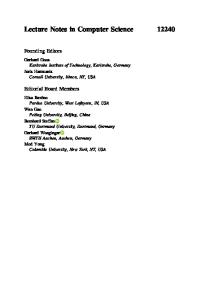A framework for registration of multiple point clouds derived from a static terrestrial laser scanner system
- PDF / 2,710,769 Bytes
- 17 Pages / 595.276 x 790.866 pts Page_size
- 21 Downloads / 326 Views
ORIGINAL PAPER
A framework for registration of multiple point clouds derived from a static terrestrial laser scanner system Giovana A. Miola 1 & Daniel R. dos Santos 1 Received: 29 November 2019 / Accepted: 31 March 2020 # Società Italiana di Fotogrammetria e Topografia (SIFET) 2020
Abstract The registration problem has been one of the most popular research topics in the geodesic applications. However, what makes the registration problem challenging are partially overlapping surfaces and when no information from the global positioning system (GPS) and inertial navigation system (INS) is given. In this paper, we propose a framework for registration of multiple 3D point clouds derived from a terrestrial laser scanning (TLS) system, which uses a closed-form coarse-to-fine scheme and globally eliminate the residual errors. The main contribution of this work lies in the closed-form multi-feature corresponding model for fine orientation task. Since the multi-feature with geometric constraint is used, a point cloud registration is more likely to be achieved. Due to the coarse orientation task corresponding point-to-plane and line features are non-iteratively obtained in this step. Consequently, a reliable alignment for the global registration solution can be achieved. The advantages of this framework are demonstrated using a challenging real dataset. Additionally, the approach is tested and evaluated against another state-of-theart algorithm. The results of the experiments indicate that a sensor pose better than 10 mm can be achieved by using this approach. Keywords Geodesy . Point cloud registration . Coarse-to-fine orientation . Closed-form solution . Multi-feature corresponding model
Introduction With increasing investments in infrastructure, civil construction projects, building information modeling (BIM), surveying complex structures, forest inventories, mapping, and inspections, the demand for 3D models of complex objects located on the surface is growing daily. Terrestrial laser scanner (TLS) are sensing systems that can provide a more costeffective way to collect spatial information of a complex area quickly and accurately, which results in a dense and unordered set of three-dimensional points, known as 3D point clouds. However, TLS sensors have an important drawback to the mapping of large surface areas: it is a line-of-sight technology. Thus, the TLS sensor (S) must be installed at different scan positions to capture all facets of the objects of interest. In
* Giovana A. Miola [email protected] Daniel R. dos Santos [email protected] 1
Federal University of Paraná, Curitiba, Brazil
practice, the operator moves the sensor around the area that is being scanned to fill missing areas and create a complete 3D point cloud. At each scan position (S1, …, Sn), the sensor collects thousands of points from a small part of the object. Furthermore, an independent local coordinate system will be established based on the initial position and orientation at each TLS station. To make use of all scans and generate
Data Loading...











